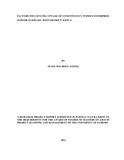| dc.description.abstract | The government of Kenya initiated WEF in 2007 to provide credit and train women,
facilitate market for their products and to help the women develop linkages with large
enterprises. These services are disbursed through C-WES that is at the district level. C-WES
operates on group loaning scheme with no collateral to women entrepreneurs. However, a
study conducted by Omollo (2011) indicate low uptake of C-WES services in Kisumu West
District. This study sought to determine the causes for the low uptake of C-WES services by
addressing four objectives. These were: establishing the extent to which access to information
influence low uptake of C-WES amongst women entrepreneurs; examining the extent to
which C-WES conditions influence low uptake of C-WES amongst women entrepreneurs;
examining the extent to which role of decision making on control of credit influence low
uptake of C-WES amongst women entrepreneurs; and examining the extent to which women
business skills influence low uptake of C-WES amongst women entrepreneurs in Kisumu
West District. In order to conclusively address the research objectives, the study adopted a
descriptive survey design with qualitative and quantitative approaches to data collection. The
data employed both probability and non-probability sampling techniques. Under probability
sampling, the simple random technique was used to identify respondents. Using Krejcie and
Morgan (2002) table of determining sample size, 368 women were sampled from women
groups registered by Ministry of Gender and Social Services. Another 6 respondents were
purposively sampled for key informant interviews. Analysis involved descriptive statistics and
content analysis hence the researcher ran frequency distributions, percentages and means
while data was also presented in tables. Qualitative information obtained through in-depth
interviews was summarized into briefs. From our findings the study established that 35% of
women had not heard of C-WES services, while majority of those who knew about C-WES
services (44.9%) got the information mainly from friends and families. Majority of the women
found the C-WES conditions favorable at 71.2%. However, not all the women groups had met
the required conditions with 43% of women not having group records. The findings also
established that even though women made decisions on use of profit and the type of business
to start, 64.1% still needed permission from men to gain credit and 53.8% needed permission
to attend group meetings. Finally, over 95% of respondents supported training programs for
C-WES. The study recommended that C-WES needed to raise awareness on its services. CWES
also needed to design effective monitoring program as a feedback tracking mechanism
on women groups. The study also recommended a holistic approach in implementing C-WES
services particularly during training. This would help in enhancing women decision making
power. The study recommended policy change to allow for use of vernacular languages in
designing information materials that include posters and brochures | en |

